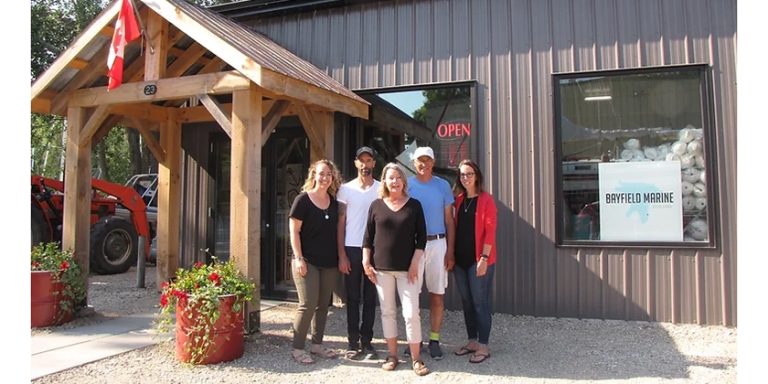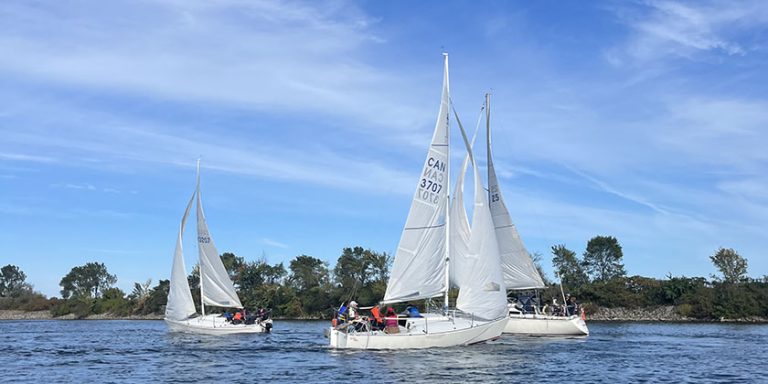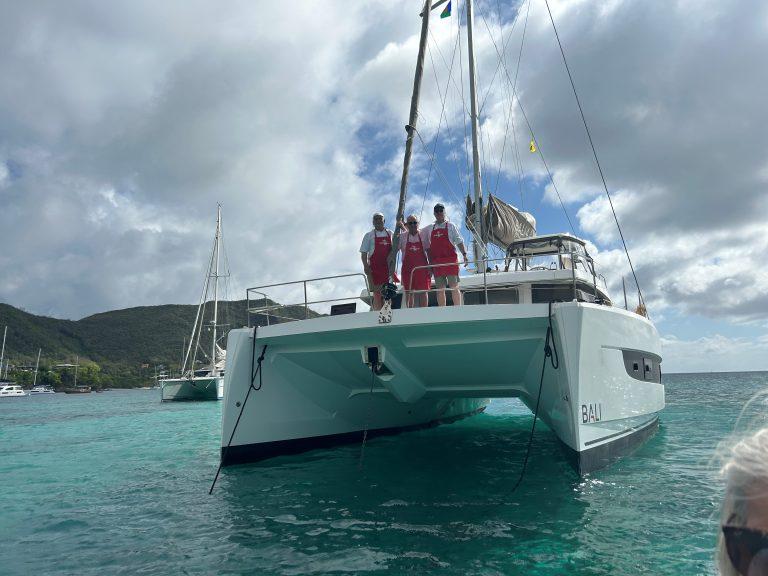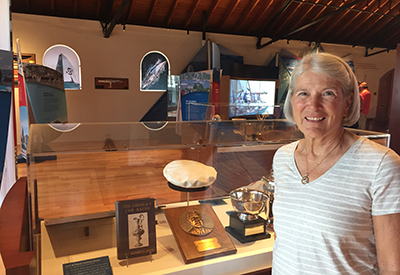Alexandra Yacht Club
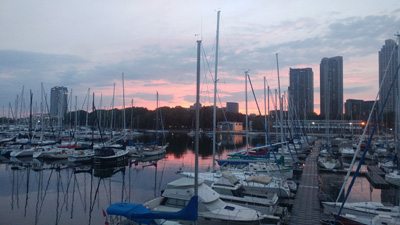
Western sky pink glow of AYC harbour.
By: Katherine Stone
In the early 1800s before the Toronto Islands existed, this same location consisted of a long peninsula that extended from the foot of the present-day Woodbine Avenue. The peninsula was built of sand carried all the way from the Scarborough Bluffs by the wave action. The area was a primeval forest with crystal clean rivers that teemed with fish. The eastern part of the peninsula consisted of an eight square kilometer marsh which ran from the mouth of the Don River to what we now know as the foot of Leslie Street.
A winter storm in 1858 erased the peninsula by creating a channel we now know as the Eastern Gap and a series of lagoons and inlets we now refer to as the Toronto Islands. The eastern end of the sandbar became known as Fisherman’s Island and was a paradise for whitefish, herring and salmon fishing. There were also Sturgeon in abundance, big enough to sink a boat. Fishermen’s huts dotted the area and were often demolished by the wild waves of Lake Ontario. All the land north of Front Street, west of Jarvis and south of King and east to Church was declared Market Block, where the fishermen sold their catch.
Once home to a thriving fishing community, Fisherman’s Island – its name and place – have vanished from the Toronto landscape. You will be hard pressed to find out where this mysterious island once was. Although the name was lost, the sands still remain as Toronto’s Cherry Beach.
 In 1906 a group of interested boaters approached the Assessment Commissioner for a site to be used for boating. For a rental of $20/year the narrow sandbar running south from Cherry Street to the east end of Toronto Bay, Fisherman’s Wharf, Fisherman’s Island was granted to Alexandra Yacht Club, named after the consort of King Edward VII. (One wonders if the Queen ever knew about this tiny boating club in far off Canada).
In 1906 a group of interested boaters approached the Assessment Commissioner for a site to be used for boating. For a rental of $20/year the narrow sandbar running south from Cherry Street to the east end of Toronto Bay, Fisherman’s Wharf, Fisherman’s Island was granted to Alexandra Yacht Club, named after the consort of King Edward VII. (One wonders if the Queen ever knew about this tiny boating club in far off Canada).
The pileup of ice was too much for the pilings which collapsed and sent the clubhouse into the lake and damaged many members boats in 1919
Although the City Property committee chairman stated, “I am not prepared to recommend that any control of the water be given to the club, although I think that they should be allowed to moor their boats in front of the clubhouse providing this does not interfere with other interests.” The boaters got rights to work and the two-storey clubhouse was built with the lower level used for boat storage. There were two ramps leading to the water’s edge and a balcony at the front, facing west, which provided a magnificent view of the Toronto bay.
By 1911 the annual Senior dues were set at $3.00 and Proposition dues at $1.00. Quite a strange name for what we might now call Social or Associate members who did not own boats! This lovely spot was not to last long. That same year, the city transferred all of Ashbridge’s Bay, the marsh and waterfront lands to the newly formed Toronto Harbour Commission (THC) for development of commercial docks which would obliterate Fisherman’s Island.
They appealed to the mayor for help finding an alternative site in 1914. This was granted and the clubhouse was to be moved across the bay on barges and set up on steel piles on the northeast end of Ward’s Island (Ward’s Point) some 300 feet from the shore line. Ironically, Ward’s Point was another sand bar created by the city’s dredging program.
Transportation to the new location across the bay created its own unique problem resulting in a loss of members. However, the club continued to be very socially active with 78 members and were able to hang on financially where other area sporting clubs struggled. As with most clubs during the war years, incoming dues dwindled and member manpower was almost non-existent. Listed among their assets was a piano worth $375 which was moved to the commodore’s house during the fall of 1918. In hindsight this was a wise decision. Several months later, the clubhouse collapsed from ice pushed up against the unsupported pilings and many members’ boats were damaged. Needless to say, the result on the club and its members was truly devastating.
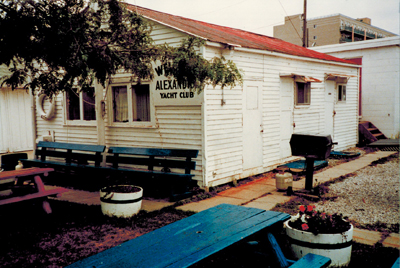 Although it wasn’t grand, the AYC clubhouse in 1978 was welcoming.
Although it wasn’t grand, the AYC clubhouse in 1978 was welcoming.
Again, a delegation of members approached the THC for help. They gave their support and offered a site at the foot of Bathurst Street (next to where the National YC had moved several years earlier). The new location was not ideal as a large sandbar was directly in front of where the clubhouse would sit, with a depth of only 14 inches, making it almost impossible to launch anything but a canoe. Immediate plans were made for a dinghy house which was completed by the Fall. Although dredging commenced, the area continued to silt in. With the loss of members to other clubs and the money all used up to construct the dinghy house, the club sunk deeper into debt. By 1932 back taxes had not been paid for many years. Times were tough during the Depression and during WWII and many other clubs were in the same boat.
The club then moved from the corner location, 100 feet further south with 150 feet of water frontage that they would occupy until 1987 for an annual rate of $1.00/ft. The clubhouse was moved, and then a covered veranda, proper washrooms, paving and sodding were added. In April 1938 the club applied for and obtained its charter. In June 1988, the opening ceremonies were held for their fourth and current two-story building constructed on landfill on the north side of the Western Gap across from the Island Airport. Through all the lean years, the Alexandra Yacht Club was fortunate to have a sympathetic landlord, the Toronto Harbour Commissioners, to which they owe a great debt of gratitude.
The following invitation was extended to entice those interested boaters to become ‘Prospective Members’, “If you own a boat and wish to moor it where good fellowship is more important than ‘style’, slip down behind the Tip Top Tailor building and meet some unostentatious sailors who will be pleased to shake your hand and offer to you their co-operation in your sailing and motor boating activities.”
Through all the upheaval, the Alexandra YC still managed to maintain their membership with the Lake Yacht Racing Association and Lake Sailing Skiff Association, hosting regattas in 1916 and 1934. AYC members also participated in many local regattas during this time frame.
Today, the Alexandra YC holds a Spring and Summer racing series on Thursday nights divided into flying and non-flying sails. As a club they have had great participation and winning boats in interclub racing since the 1920s. AYC boats that have participated in the Lake Ontario 300 have finished on the podium. As a founding member of the AHMEN series, (The A in AHMEN is AYC) they host one of the largest racing series in the province. As a club they certainly seem to win far more races than their numbers would suggest.
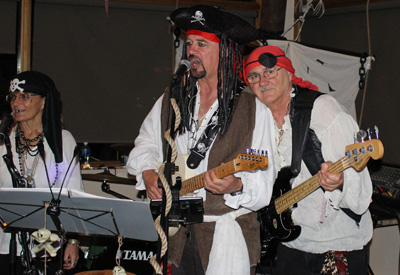 The House Band that plays for Spring Fling and Halloween.
The House Band that plays for Spring Fling and Halloween.
Many of the members focus more on member-run fun events. It remains an active Self-Help club with 100 Senior and 25 Associate members who enjoy both sail and power boats. Members contribute a minimum of 16 work hours to help maintain upkeep and repairs to the property. Dockage consists of several interconnected floating docks and a number of swing moorings. Best of all are the social events and informal winter activities in an ideal location close to downtown Toronto and public transit.
Their setting is relaxing in the heart of the city with a close-knit community feel where the members are focused 100% on boating. Within minutes you are out of the harbour and able to go boating around Toronto Islands or into the harbour. From member-driven potlucks to the big dinner dance Sail Past party where members can bring family and friends, or the Almost Around the Island Hog Fest (a very relaxed race around the Toronto Islands) to the Halloween party featuring the house band, there is something for everyone. In keeping with their community driven membership, last year 220 people attended the Sail Part pasty and raised $850 for the Broad Reach Foundation. Their kitchen is a “do-it-yourself” operation with 2 ranges and a good size dining area with a fireplace. Outside they have a large parking lot, 2 BBQs and oodles of outdoor seating. All the amenities are there with pump out, shore power and water.
 Great dining views of the harbour – even in winter.
Great dining views of the harbour – even in winter.
What draws people to Alexandra Yacht Club? Members will tell you that the DIY spirit, close-knit community, outstanding location, member-driven and friendly atmosphere are what attracted them and still keeps them coming down to 2 Stadium Road every year. Because their membership is small, every event is a great opportunity to socialize and catch up with friends who have become family. For a club that almost didn’t make it, they certainly have a winning formula now!
Alexandra Yacht Club; 2 Stadium Road; Toronto, Ontario M5V 2R9; 416-260-8690 https://www.ayc.ca/



